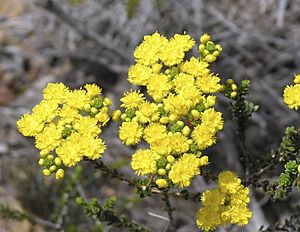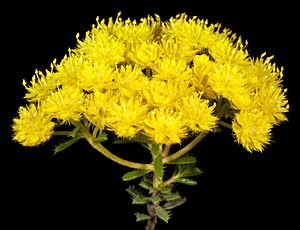Verticordia serrata facts for kids
Quick facts for kids Verticordia serrata |
|
|---|---|
 |
|
| Verticordia serrata growing in the Boyagin Nature Reserve near Pingelly | |
 |
|
| Scientific classification | |
| Genus: |
Verticordia
|
| Species: |
serrata
|
Verticordia serrata is a beautiful flowering plant that belongs to the myrtle family, called Myrtaceae. This plant is special because it only grows in the south-west part of Western Australia. It is a shrub with thin, open branches. Its leaves are hairy and shaped like an egg. The flowers start out golden, then slowly change to a greyish color.
Contents
What Verticordia serrata Looks Like
Verticordia serrata is a shrub that grows with open branches. It can reach about 1.5 m (5 ft) tall and usually has one main stem.
Its leaves can be different shapes depending on the type of plant. Some leaves are oval or egg-shaped, about 2.5–6 mm (0.1–0.2 in) long. Other leaves are long and thin, like a line, measuring 6–20 mm (0.2–0.8 in) long. No matter the shape, all the leaves have hairy edges.
The flowers often smell nice. They grow in groups on straight stems that are 3–8 mm (0.1–0.3 in) long. The longest stems are found on the lowest flowers in each group. The base of the flower, called the floral cup, is 0.5–1.0 mm (0.02–0.04 in) long. It has small bumps and is smooth, without hairs.
The sepals (leaf-like parts that protect the flower bud) spread out wide. They are golden-yellow at first, then turn grey as they get older. Each sepal is about 2.5–3.5 mm (0.098–0.14 in) long and has 6 to 8 hairy sections. The petals (the colorful parts of the flower) are similar in color to the sepals. They are 2.5–4 mm (0.1–0.2 in) long and egg-shaped with a jagged edge. The style (the part of the flower that receives pollen) is 2–4 mm (0.08–0.2 in) long, straight, and smooth. The time when the plant flowers changes depending on the type.
How Verticordia serrata Got Its Name
This plant was first officially described in 1839 by a person named John Lindley. He gave it the name Chrysohoe serrata. This description was published in a book called A Sketch of the Vegetation of the Swan River Colony.
Later, in 1841, another scientist named Johannes Conrad Schauer changed the name to Verticordia serrata.
In 1991, Alex George studied the Verticordia group of plants very closely. He found and described three different types, or varieties, of Verticordia serrata:
- Verticordia serrata var. serrata: This type has oval or egg-shaped leaves with hairs up to 0.5 mm (0.02 in) long. Its style is up to 2.8 mm (0.11 in) long. It flowers from October to January.
- Verticordia serrata var. ciliata: This type has leaves similar to var. serrata, but its leaf hairs are longer, and its style is also longer. It flowers from September to December.
- Verticordia serrata var. linearis: This type has long, thin, pointed leaves. It flowers from September to October.
Where Verticordia serrata Grows
This plant grows in the south-west part of Western Australia. Each of the three varieties can be found in slightly different areas. The most common type, var. serrata, grows from near Perth all the way inland to Koonadgin and along the coast as far east as Raventhorpe.
All types of Verticordia serrata grow in sandy soil. Sometimes the soil also has gravel, loam, or clay. They are often found in areas with shrubs and trees, and sometimes grow near other types of verticordia plants.
Protecting Verticordia serrata
The variety linearis is listed as "Priority Three". This means that we don't know much about it, and it's only found in a few places. However, it is not in immediate danger of disappearing. The other two varieties are not considered to be threatened.
Growing Verticordia serrata in Gardens
All three types of Verticordia serrata can be grown from cuttings, which are small pieces of the plant that can grow roots. The variety linearis is the easiest to start this way.
These plants are described as "ornamental" and "attractive," meaning they look good in gardens. They can sometimes grow slowly, but once they are established, they seem to be strong and healthy plants.

